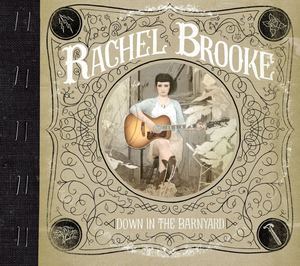
Down in the Barnyard: Visionary Music by Rachel Brooke
Written by: Pat King, Special to CC2K
 Does anyone just listen to music these days? I mean, just sit by themselves or with friends in their friendly domicile and just lay around and really just get into the melody?
Does anyone just listen to music these days? I mean, just sit by themselves or with friends in their friendly domicile and just lay around and really just get into the melody?
I wonder about that.
I think that music should stimulate vision. Our minds should do a little work. Music. Just think of the absurdity of it. Sounds that move us to vision. In this way, I think, music is intimately linked with literature. The fiction writer, the poet, the old bluesman, can only suggest. The rest is personal. The rest is up to the audience.
You should do yourself a favor and listen to Rachel Brooke’s Down in the Barnyard in a quiet place, with nothing to distract you. Pay attention and give yourself fully to the music. You will be rewarded, trust me. It was just an insane sort of trip sitting on the couch listening to the album, comfortable, relaxed, letting the visions come to me.
Down in the Barnyard is a spooky album that begins and ends with death. Appropriate enough. We Americans could use a little more abyss contemplation. The opening song, “The Barnyard,” is a short story without a chorus. It’s about a teenage girl and boy who go to a barn to make out. The girl’s lover, caught up in passion, calls the girl by the wrong name, that of her best friend. So the girl kills her boyfriend and then seeks out her friend and does the same. The last song on the album, “Don’t Forget me When I Die” is a rollicking banjo tune with a bit of a white-gospel feel to it. It’s an upbeat song about death. So we begin with sorrowful death and end with a plea for remembrance, the celebratory side of death. Dying, and our reaction to it, is just as multifaceted as life.
One of my favorite songs on the album is “Must Be Somethin’ In The Water.” I’ll tell you what I experienced, lying there on my couch, listening to this thing. Dread. Foreboding. Something terrible waiting just outside the door. It’s rare that I feel such genuine spookiness from a song. I mean, there’s plenty of dread in life, but in art? For shame. It’s a rare thing, indeed. How does Rachel evoke such primal emotions with just a strumming acoustic guitar and heavenly voice? Fuck if I know. I’m a writer, trying to understand something I’ll never have any talent for. This is something akin to magic to me. But real magic. No tricks. Ritual, alchemy, those kinds of things. Something from nothing. I feel like some kind of ape banging a rock against a tree compared to someone who’s able to cast this kind of spell.
But the song’s not over. Not yet. Suddenly, near the end, something spectacular happens. The acoustic strumming stops and then there’s loud, clanging drums and electric guitar. You don’t see it coming. It seems to come from nowhere. Now the dread is of a new flavor. It’s now piercing, mourning. But amidst the chaotic clanging, there’s Rachel’s voice, unchanged by the violence, still sad, somehow soothing.
Besides the electric guitar and drums at the end of that song, there’s almost nothing modern about this album. That is to say it’s definitely a country album, but one that evokes styles from the mid-1950’s back to the birth of the genre. We hear echoes of the Carter Family, Hank Williams, a little Jimmie Rodgers. The album made me feel like I was in another time, while at the same time keeping things grounded in the present. There was a strange kind of cognitive dissonance at work here, the brain pulled in all sorts of directions at once. There’s so much depth here. So much room for vision, for contemplation. It’s metaphysical country music. But the good stuff always is.
To borrow from the great Dean Moriarty: This woman knows time. Dig?
